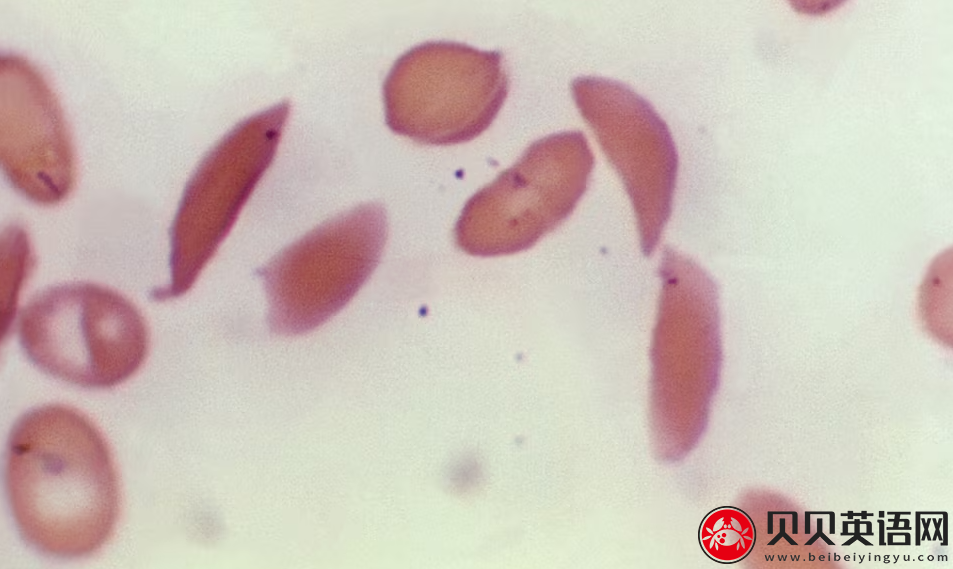欢迎访问贝贝英语网!
United States health officials last week approved two gene treatments for sickle cell disease. Doctors hope that the treatments will provide a cure for the painful genetic blood disorder.
The U.S. Food and Drug Administration (FDA) said the one-time treatments can be used for patients 12 and older with severe forms of the disease.
One treatment is made by Vertex Pharmaceuticals and CRISPR Therapeutics. The other is made by Bluebird Bio.
“Sickle cell disease is a… life-threatening blood disorder with significant unmet need,” the FDA’s Dr. Nicole Verdun said in a statement announcing the approvals. “We are excited to advance the field especially for individuals whose lives have been severely disrupted by the disease.”
Sickle cell disease (or SCD) affects millions of people worldwide. The disease is common in places with high cases of malaria, like Africa and India. Scientists believe being a carrier of SCD helps protect against severe malaria.
It is more common among Black Americans, Africans, and Middle Easterners than other population groups. The World Health Organization said many children with the most severe form of the disease die before the age of five, usually from an infection or severe blood loss.
The new treatments
A genetic change, or mutation, causes blood cells to become defective in people with sickle cell disease. The unhealthy blood cells result in blockages, called blood clots. The clots cause pain and damage to bones and organs in the human body.
The Vertex treatment is called Casgevy. Its goal is to help the body go back to producing healthy blood cells that are present at birth. It uses CRISPR, the gene editing tool, to knock out a gene in stem cells collected from the patient.
Bluebird’s treatment, called Lyfgenia, aims to add copies of a modified gene. The modified gene helps red blood cells to produce a protein that prevents or reverses unhealthy cells.
The two gene treatments are the first approved in the U.S. for sickle cell disease. Vertex is already approved in Britain and Bahrain.
The new treatments are costly. The cost for Bluebird Bio is $3.1 million and for Vertex, $2.2 million. To help cover the cost, the U.S. Centers for Medicare and Medicaid says it plans to create partnerships with state Medicaid agencies and drug companies.
Even with the high cost, many patients say they would consider the gene treatment because of the seriousness of the disease.
Jalen Matthews of Louisville, Kentucky, was diagnosed with sickle cell at birth. She had her first pain episode at age 9. Three years later, the disease led to a spinal cord stroke that left her with some paralysis in her left arm and leg.
“I had to learn how to walk again, feed myself, clothe myself, basically learn how to do everything all over again,” said Matthews, who is now 26.
Today, she deals with the disease by having blood transfusions. About every two months, the treatment replaces five units of her blood with healthy cells. She said she plans to ask her doctor about the new treatments.
“This one-time kind of cure is very much needed,” Matthews said.
Studies testing the treatments suggest they work well. Of 31 people treated in the Vertex study with enough follow-up, 29 were free of pain episodes for at least a year. In the Bluebird study, 28 of 32 patients had no severe pain or organ damage between six and 18 months after the treatment.
But doctors note there are possible side effects. They also say the long-term results are unknown. For both treatments, the required chemotherapy comes with risks such as infertility, hair loss and serious infections.
With the Bluebird treatment, blood cancer has happened. The FDA said it will include a “black box warning” about that risk.
With the Vertex therapy, some scientists worry that CRISPR brings the possibility of “off-target effects.” These are unexpected changes to a person’s genome.
I’m Anna Matteo.

参考译文:
美国卫生官员上周批准了两种用于镰状细胞病的基因治疗。医生们希望这些治疗方法能够为这种疼痛性的遗传性血液疾病提供治愈。
美国食品和药物管理局(FDA)表示,这些一次性治疗方法可用于年龄在12岁及以上、患有重度疾病形式的患者。
其中一种治疗方法由维生素制药公司和CRISPR Therapeutics公司制造。另一种由Bluebird Bio公司制造。
FDA的Nicole Verdun博士在宣布批准的声明中说:“镰状细胞病是一种危及生命的血液疾病,存在着显著的未满足需求。我们为能够推动该领域的发展而感到兴奋,尤其是对于那些生活受到该疾病严重干扰的人们。”
镰状细胞病(或SCD)影响着全球数百万人。这种疾病在疟疾病例较高的地方较为常见,如非洲和印度。科学家认为,携带SCD基因有助于防止严重疟疾。
相较于其他人口群体,黑人美国人、非洲人和中东人群患此病的几率更高。世界卫生组织表示,许多最严重形式的疾病患儿在五岁之前死亡,通常是由于感染或严重失血。
新的治疗方法
在患有镰状细胞病的人体内,基因发生变异,导致血细胞变得有缺陷。这些不健康的血细胞会导致被称为血栓的堵塞。这些血栓会导致人体内骨骼和器官的疼痛和损害。
维生素公司的治疗方法名为Casgevy。其目标是帮助人体恢复到在出生时存在的健康血细胞的产生。它使用CRISPR基因编辑工具来消除从患者采集的干细胞中的一个基因。
Bluebird的治疗方法名为Lyfgenia,旨在添加修改过的基因副本。修改过的基因有助于红细胞产生一种预防或逆转不健康细胞的蛋白质。
这两种基因治疗是美国批准用于镰状细胞病的第一种。维生素公司已经在英国和巴林获得批准。
新的治疗方法成本较高。Bluebird Bio的费用为310万美元,维生素公司为220万美元。为了帮助支付成本,美国医疗保险与医疗补助中心表示计划与各州医疗补助机构和制药公司建立合作伙伴关系。
尽管成本高昂,许多患者表示考虑接受基因治疗,因为这种疾病的严重性。
肯塔基州路易斯维尔市的Jalen Matthews在出生时被诊断患有镰状细胞病。她9岁时经历了第一次疼痛发作。三年后,这种疾病导致了一次脊髓中风,使她的左臂和左腿部分瘫痪。
现年26岁的马修斯今天通过输血来处理这种疾病。大约每两个月,这种治疗方法用健康的细胞替换她的五个血细胞单位。她表示计划向医生询问新的治疗方法。
马修斯说:“这种一次性的治疗非常需要。”
对这些治疗方法的研究表明它们效果良好。在维生素研究中,经过足够时间跟踪的31名受试者中,有29人在至少一年的时间里没有疼痛发作。在Bluebird研究中,在治疗后6到18个月内,32名患者中有28名没有严重的疼痛或器官损伤。
但医生们指出可能存在副作用。他们还表示长期效果尚不清楚。对于这两种治疗方法,所需的化疗可能带来不孕、脱发和严重感染等风险。
对于Bluebird治疗方法,已经发生了血液癌症的情况。FDA表示将包含有关这一风险的“黑匣子警告”。
对于维生素疗法,一些科学家担心CRISPR可能带来“离靶效应”的可能性。这是对个体基因产生意外变化的情况。
_________________________________
Words in This Story
advance - v. to move forward
knock out - phrasal verb, to cause something to stop working
reverse - v. to return to an earlier state
episode - n. a short time of an illness
paralysis - n. a condition in which you are unable to move
blood transfusion - n. a medical treatment in which someone's blood is put into the body of another person